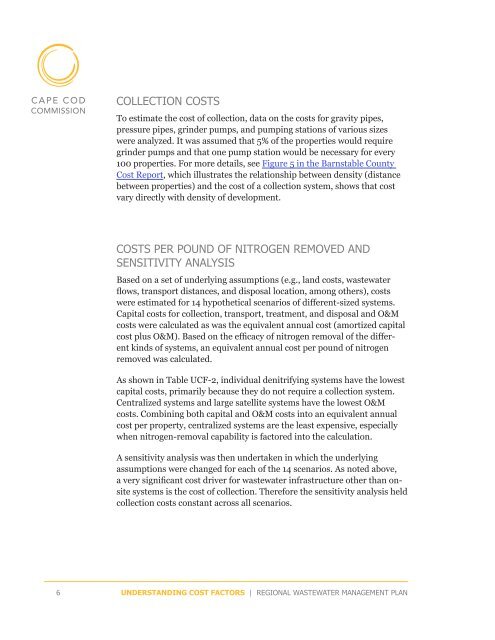Understanding the Cost Factors of Wastewater Treatment & Disposal
Understanding the Cost Factors of Wastewater Treatment & Disposal
Understanding the Cost Factors of Wastewater Treatment & Disposal
You also want an ePaper? Increase the reach of your titles
YUMPU automatically turns print PDFs into web optimized ePapers that Google loves.
COLLECTION COSTS<br />
To estimate <strong>the</strong> cost <strong>of</strong> collection, data on <strong>the</strong> costs for gravity pipes,<br />
pressure pipes, grinder pumps, and pumping stations <strong>of</strong> various sizes<br />
were analyzed. It was assumed that 5% <strong>of</strong> <strong>the</strong> properties would require<br />
grinder pumps and that one pump station would be necessary for every<br />
100 properties. For more details, see Figure 5 in <strong>the</strong> Barnstable County<br />
<strong>Cost</strong> Report, which illustrates <strong>the</strong> relationship between density (distance<br />
between properties) and <strong>the</strong> cost <strong>of</strong> a collection system, shows that cost<br />
vary directly with density <strong>of</strong> development.<br />
COSTS PER POUND OF NITROGEN REMOVED AND<br />
SENSITIVITY ANALYSIS<br />
Based on a set <strong>of</strong> underlying assumptions (e.g., land costs, wastewater<br />
flows, transport distances, and disposal location, among o<strong>the</strong>rs), costs<br />
were estimated for 14 hypo<strong>the</strong>tical scenarios <strong>of</strong> different-sized systems.<br />
Capital costs for collection, transport, treatment, and disposal and O&M<br />
costs were calculated as was <strong>the</strong> equivalent annual cost (amortized capital<br />
cost plus O&M). Based on <strong>the</strong> efficacy <strong>of</strong> nitrogen removal <strong>of</strong> <strong>the</strong> different<br />
kinds <strong>of</strong> systems, an equivalent annual cost per pound <strong>of</strong> nitrogen<br />
removed was calculated.<br />
As shown in Table UCF-2, individual denitrifying systems have <strong>the</strong> lowest<br />
capital costs, primarily because <strong>the</strong>y do not require a collection system.<br />
Centralized systems and large satellite systems have <strong>the</strong> lowest O&M<br />
costs. Combining both capital and O&M costs into an equivalent annual<br />
cost per property, centralized systems are <strong>the</strong> least expensive, especially<br />
when nitrogen-removal capability is factored into <strong>the</strong> calculation.<br />
A sensitivity analysis was <strong>the</strong>n undertaken in which <strong>the</strong> underlying<br />
assumptions were changed for each <strong>of</strong> <strong>the</strong> 14 scenarios. As noted above,<br />
a very significant cost driver for wastewater infrastructure o<strong>the</strong>r than onsite<br />
systems is <strong>the</strong> cost <strong>of</strong> collection. Therefore <strong>the</strong> sensitivity analysis held<br />
collection costs constant across all scenarios.<br />
6<br />
UNDERSTANDING COST FACTORS | REGIONAL WASTEWATER MANAGEMENT PLAN
















